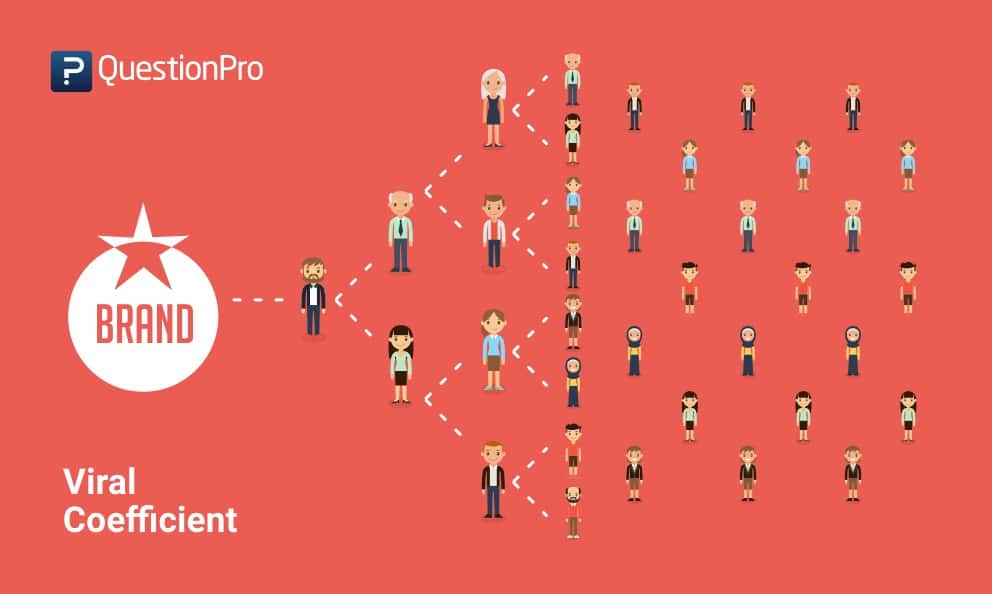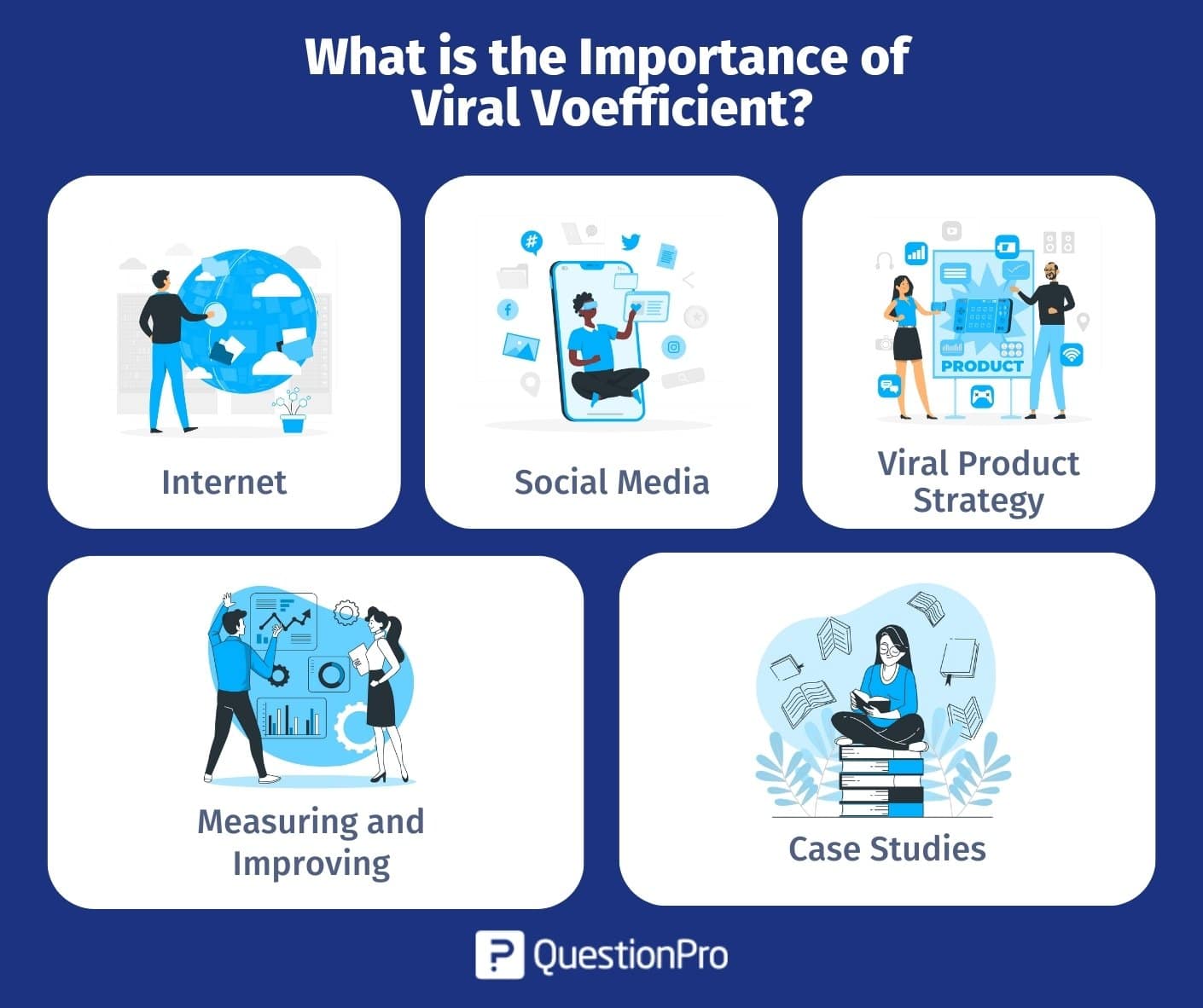
In today’s digital age, viral marketing has become essential to any successful online business or campaign. One key metric that determines the success of viral marketing is the Viral Coefficient. Understanding the Viral Coefficient can help businesses gauge the effectiveness of their marketing strategies and assess their potential for exponential growth.
This blog post will explore the definition, calculation, and importance, as well as the advantages and disadvantages of the Viral Coefficient in driving organic growth and viral success.
Also Read: Customer Lifetime Value (CLV)
The Viral Coefficient, also known as the Viral Growth Coefficient or K-factor, measures the rate at which existing product or service users bring in new users through word-of-mouth or viral means. It essentially represents the average number of new users each existing user generates over a given time period.
The formula for calculating the Viral Coefficient is straightforward:
Viral Coefficient (K) = Number of Invites Sent per User x Conversion Rate
In this equation:
- Number of Invites Sent per User: This is the average number of invites that an existing user sends to potential new users.
- Conversion Rate: This represents the percentage of recipients who accept the invitation and become new users.
Learn more: A complete guide on Net Promoter Score (NPS)
Any business typically works and depends on solid numbers. The hypothesis only works when strategies need to be built. Whether it is sales or marketing, or even production, numbers matter, so it is important that facts are represented in the form of numbers. Let us understand how to calculate the viral coefficient for your business using the following steps:
- Let us take the number of your current number of customers. Let’s say they are 10000.
- Multiply this number by the number of invites your current customers send to their friends, family, or colleagues. Getting this number won’t be an issue if your business is online. However, if your business operates offline, some research will be required to acquire the necessary statistics. Let’s say that the number of invites is 1500.
- Next, you will need to find the percentage of those invites that got converted into your customers. Find the percentage of those invitees who became your new customers. Let’s say that’s 10%.
- So, if 10,000 of your consumers sent out even 15 invites each, that becomes 150,000 invites. So 10% of 150,000 become your new customers, that becomes 15,000.
- So technically, you have acquired 15,000 new customers. That makes 25,000 customers in total for your business.
- Divide the number of new consumers acquired by the number of existing consumers, and you will calculate viral coefficient. So, in this case, it will be: 15000/1000 = 1.5
So your current viral coefficient is 1.5
There are two important things while calculating the viral coefficient:
Acquisition
Please note in the calculations above, the numbers play an important role. It is the actual number of people converting to become your customers. If each of your customers sends out 200 invites, but none of the people join, then your viral coefficient becomes 0. So be careful about the number of acquisitions.
Realistic numbers
It is unlikely that a customer is going to keep inviting his/her friends repeatedly. It is advisable to live in the present and work on real-time numbers.
Learn more: Customer Equity and Net Promoter Score
The importance of the viral coefficient lies in its ability to drive exponential growth for a business or product through word-of-mouth marketing and customer referrals. Here are the key reasons why is viral coefficient important:

Internet
The internet is a powerful network, and many opportunities can be trapped here for new and aspiring companies. Through the internet, open communication is facilitated at a relatively low cost of putting up the content on the web. At the same time, it is one of the most powerful ways of communicating with your customers locally and globally and vice versa.
Social media
The dynamic growth of social media platforms like Facebook, Twitter, LinkedIn, and other similar platforms like Instagram and Tumblr can be attributed to having a positive viral coefficient and the network effects that are leveraged when current customers use the products from a particular brand and share their usage stories with their friends and family.
Viral product strategy
As it is clear from the example above, a business’s focus should be to improve its viral coefficient continuously. This will, in turn, greatly improve your product and the ability to acquire new customers.
Rarely do companies run out of business due to a lack of products. The lack of customers kills a business, more precisely, the lack of a dynamic strategy to acquire new customers.
Measuring and improving
A positive viral coefficient means a business is constantly acquiring new customers and growing exponentially. Customer acquisition can be difficult, but by focusing on your product strategy and improving your viral coefficients, you will be able to give your business a better opportunity to grow and succeed.
Case studies
Present real-life examples of companies that successfully leveraged their viral coefficient to achieve viral growth. Analyze their strategies and outcomes to provide actionable insights.
Learn more: 50+ FREE Product Surveys
Viral coefficient calculation example
The viral coefficient is defined as the number of new consumers or customers that an existing satisfied customer generates. As the term suggests, this metric calculates the exponential referral cycle.
This phenomenon is called the “virality” that helps in the company’s growth. Virality is the ingrained incentives that existing customers receive upon referring friends, family, or colleagues to a company or a brand.
Consider hypothetically, there are two clothing brands, A and B. Both these brands were launched around the same time, and both are into varied clothing designs. Over a couple of months, brand B started performing extremely well, whereas brand A continued to struggle.
The point to be noted here is that the quality, designs, pricing, showroom location, and other similar factors for both these brands are identical.
However, brand B has a greater number of consumers than brand A. This difference is easy to explain. The viral coefficient or virality helped brand B perform better than brand A. How? Well, marketing exists in many forms.
Consider social media for instance, you can tweet, you can post your messages on LinkedIn and Facebook, you can also use Adwords for advertising, write blogs, and so forth. This list is virtually endless. However, there is one market research method that some people might call old school, yet it significantly differs in how people view your brand, and that is “word of mouth.”
This is where consumers start to view your brand differently. An existing customer who recommends your brand to his/her family, friends, or colleagues seems to work wonders! Imagine the kind of exponential growth a business will witness when they have the right combination of new age and traditional marketing.
Learn more: A complete guide on Net Promoter Score (NPS)
- A positive viral coefficient is a good indicator of an organization’s achieving exponential growth and trajectory. This metric is the result of a good product itself. If a product is good, it will attract positive comments. So improving virality starts with improving the product.
- The most viral products are the ones that have not only taken the internet by surprise but also have received great reviews from users. A viral coefficient greater than one is required for marketers to evaluate and forecast the spread of word-of-mouth.
- This is a metric that will not change on its own. A positive viral coefficient depends solely on the product. The better the product, the more be will the viral coefficient.
- A positive viral coefficient metric can only be obtained if the viral cycle time is short. This means the time taken for customers to invite their family/friends and those referrals becoming new customers should be short and quick. The shorter the viral cycle, the sooner the company will grow.
Learn more: What is Market Research?
Conclusion
In the competitive digital landscape, the viral coefficient is a vital metric that can make or break a product’s success. Understanding its definition, calculating it accurately, and working towards improving it are essential steps for businesses and marketers aiming to harness the power of a viral company’s growth trajectory.
By creating compelling and shareable experiences, brands can tap into the immense potential of viral coefficients and propel their growth to new heights. It is a critical metric for assessing the virality and growth potential of QuestionPro.
By understanding how many new users are generated through each existing user, the platform can fine-tune its strategies to maximize organic growth and user engagement, leading to sustained success in the market.







